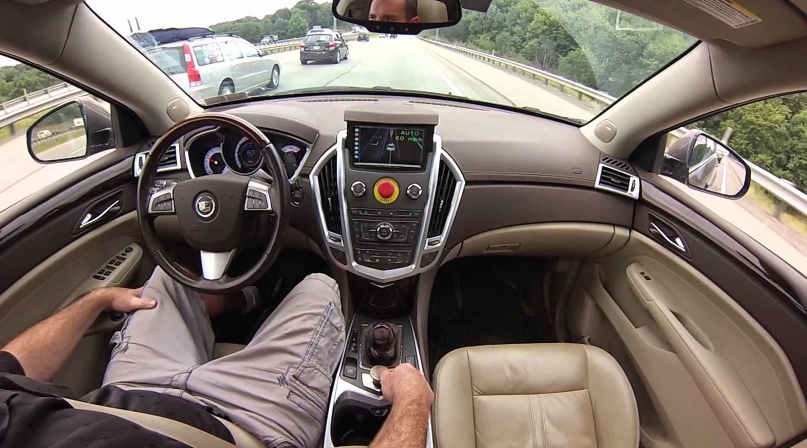Challenges and Opportunities of Connected and Automated Vehicles for Local Governments
Author
Constantin Samaras
Upcoming Events
Related News

Counties will see three phases in transition to adopting autonomous vehicle technology
Automated and connected vehicles are increasingly common on U.S. roads. In Pittsburgh, Carnegie Mellon University’s autonomous and connected research vehicle communicates with nearby traffic signals via dedicated short range communications, or DSRC, to learn about current and planned green-signal phases for driving decisions (above). Connected vehicles can communicate with other DSRC-equipped vehicles, infrastructure and smartphones. A fleet of autonomous UBER vehicles offers hands-off-the-wheel rides for passengers in Pittsburgh and elsewhere. Many other automated and connected research vehicles are out on the road. While human drivers are still behind the steering wheels of all of these vehicles right now, local governments need to plan for the transition to driverless and connected vehicles in the future.
Local governments face numerous challenges and opportunities with the introduction of this new technology. Here, we discuss three phases of this transition: 1) partial automation and connectivity of vehicles; 2) highly automated vehicles; and 3) driverless vehicles. As the technology is introduced, all three of these types of vehicles can be expected to be on the road at the same time. We will highlight some of the challenges and opportunities.
Partial Automation and Connectivity
We are already in this phase of the transition. Many new vehicles offer a variety of “driver assist” features, including automatic braking to avoid forward collisions and automated parking. Fortunately, even the first generation of these technologies has led to crash reductions and local governments should benefit from these safer roads. In the meantime, we expect system performance to improve and cost to decline, although we hope that users’ driving attention doesn’t also decline when using these vehicles.
Adaptive cruise controls, which automatically adjusts vehicle speed to maintain a safe distance from vehicles ahead, can also smooth and improve traffic flows.
One challenge for local governments is to start providing connectivity on their infrastructure and vehicles. For example, as new or rehabilitated traffic signals are installed, DSRC capability might be inexpensively added to help improve roadway performance as connected vehicles increase.
Highly Automated and Connected Vehicles
These vehicles incorporate sufficient capability to drive themselves, although drivers are expected to be ready to take over if the driving situation requires human attention. We are already seeing such vehicles become commercially available, such as the Tesla vehicles.
Local governments may see increased amounts of travel as driving becomes less onerous and working on other tasks is possible. Vehicles should be safer yet, and traffic violations (with the resulting revenues for traffic tickets) along with insurance charges should decline.
Parking lots often can be redesigned for greater efficiency. As shown below, current parking spaces allow room for doors to be opened and often have vehicles at different angles. Highly automated vehicles can park closely together, resulting in roughly a 20 percent increase in capacity for a parking lot.
Progressive local governments could introduce adaptive and connected traffic signals to substantially improve traffic flow. Priority could be given to high-occupancy vehicles (such as buses) or specific types of vehicles (such as emergency vehicles or large trucks). Communicating desired routes from vehicles will enable traffic signals to better accommodate flows and reduce delays.
Driverless and Connected Vehicles
While these vehicles seem like a futuristic dream, driverless vehicles are already appearing, in the form of low-speed, driverless shuttle vehicles and demonstration vehicles on test tracks.
Commuters and shoppers who paid for nearby parking will not do so with driverless vehicles available. They will either use shared-use vehicles (such as UBER, Lyft and other mobility services) or send their private, driverless vehicle away to a free parking space. Local government revenue from parking would decline as will the burden of building and maintaining parking lots. Land use implications depend upon individual decisions and local policies. With less difficult driving, sprawl may become more prevalent and overall vehicle travel could increase. On the other hand, lower parking needs and vehicle ownership may make dense development more attractive.
Private vehicle ownership could also decline, as mobility services and public transit would be less expensive without driver expenses. For long trips, rental vehicles can be used. Driverless, private mobility services and public transportation agencies will compete for some existing and new trips, while greater access and efficiency of shared-use mobility could bring more people from their homes to public transit hubs. Requirements for parking could similarly decline.
Driverless vehicles would also enable many individuals with mobility limitations such as the blind or the elderly to travel as desired.
Finally, many local government services could take advantage of driverless vehicle technology, such as driverless street-sweeping, snow plowing, parking enforcement, for example.
Local governments also need to plan for the impacts of driverless vehicles displacing many jobs in the trucking, taxi and transit industries. Although many trucking companies have challenges now in recruiting drivers, the overall loss of driving jobs will be real and painful to many.
Conclusions. Initial automated and connected vehicles are already appearing in service, so local governments should be preparing for their effects. We have outlined only some of the benefits and costs here, and the scale of the impacts often depends on local government policies and actions.
Benefits could include declines in crashes, smoother traffic flows, less demand for expensive parking and lower costs for transit and mobility services. For local governments, a number of traditional revenue sources could decline, such as parking and traffic violation revenues. Local government services can also be designed to take advantage of the new technologies. While the overall local economy is likely to be boosted by driverless cars, there will be specific economic impacts such as driver employment that can be planned for and addressed.
Attachments
Related News

U.S. House of Representatives passes SPEED Act and other permitting reform bills
On December 18, the U.S. House of Representatives passed the SPEED Act (H.R. 4776). The SPEED Act would strengthen county involvement in decision-making and make needed commonsense reforms to the federal environmental review process.

Counties and Railroads: Shared Priorities for the Next Surface Transportation Bill
County leaders from across the country have a vital opportunity to ensure their infrastructure priorities are front and center.

House lawmakers introduce bipartisan legislation to support World Cup local transportation needs
On December 2, U.S. Reps. Rick Larsen (D-Wash.-02) and Burgess Owens (R-Utah-04) introduced the Transportation Assistance for Olympic and World Cup Cities Act (H.R.6348), a bipartisan effort to strengthen local transportation systems in communities preparing to host major international sporting events
